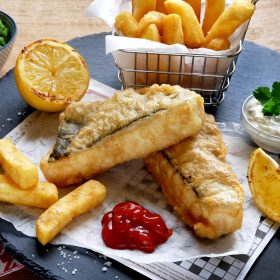New research shows seaweed might be the food of the future! Marine Scientist and Coral Reef Ecologist Nanne van Hoytema delves deep into the facts of the tastiest dish in the sea.
Over recent years, a range of seaweed has risen in popularity as part of the UK diet. Where before edible seaweed was mostly used in Asian cuisines – for example, nori for your sushi and kombu to make dashi stock – other types of seaweed have now become more common and can be found next to the spices in many local supermarkets.
It helped, of course, that three years ago a story went viral about a professor from Oregon who found a seaweed that was healthier than kale but met people’s taste for junk food. Indulging a junk food craving while still being healthy? People went nuts! That seaweed is called dulse and people have been eating it for far longer in the British Isles than you might think. The earliest records are of Irish monks harvesting it more than 1,000 years ago.
A salty history
Although most of northwestern Europeans had forgotten about seaweed as being edible, harvesting seaweed for consumption has been common around the world for thousands of years. The Romans used it for its medicinal properties and it was a main part of the diet in many coastal communities from Hawaii to Iceland. Besides being a source of food, seaweed has also maintained peoples’ livelihoods as fodder for animals, fertiliser for fields, and as a source of chemicals, like soda from kelp which led to one of the first chemical industries in the UK. The collapse of this industry in around 1800 was one of the contributing factors to the Highland clearances.
What we call seaweed, or algae, is actually a group of widely diverse forms of life that biologists (or phycologists, for all the seaweed specialists out there) have found to be quite distantly related to other plants. They fall into three main groups:
Green algae, like ulva or sea lettuce, which are closest related to other plants and share their green pigment for photosynthesis
Red algae, like dulse, which is more removed from other plants and has red pigments
Brown algae, like kelp, which is even more distantly related to the plants we are more familiar with, and get their colour from a brown pigment
Their different photosynthetic pigments also give seaweed a diverse range of where they can live in the sea, since water filters out more reddish wavelengths from the sunlight as you dive deeper down. This means red algae can grow in the deepest places in very clear waters, down to hundreds of metres below sea level. Brown algae and green algae can only grow in shallower places.
Seaweed has also found its way into various types of processed food like low-fat meat, bread products and pasta due to properties such as water retention and improved food preservation. Like many food fads, there are lots of stories out there on the miraculous benefits of seaweeds, but what do we actually know?

Dietary benefits
There are many types of seaweed and their dietary benefits vary strongly, with some containing more proteins and others more essential fatty acids. Like all parts of your diet, it is good to vary your seaweed!
The carbohydrates, or polysaccharides, in seaweed products like agar give them their gelling properties which can be used in many food products. The majority of these carbohydrates are available as dietary fibre, which is not taken up during digestion, but helps healthy digestion – similar to lentils. This means that seaweed in general does not have a very high content of digestible carbohydrates that contribute to people’s calorie intake.
Seaweeds vary in their protein content, from 30-40% of dry matter in red seaweeds, which is comparable to legumes, to green seaweeds at around 30%, and brown seaweeds at 15%. Red seaweeds score highest in essential amino acid levels too, making them a good source of many necessary proteins.
Red and brown seaweeds contain high levels of vitamins A, B and C. Brown seaweed also has high concentrations of vitamin E which helps preserve their high poly-unsaturated fatty acids levels.
Minerals make up more than 30% of a seaweed’s dry mass. A daily portion of seaweed of just 8g dry weight contributes more than half of the recommended daily allowance of calcium. Magnesium and iron can be present at even higher levels than in spinach. The only mineral which may limit seaweed consumption is iodine. This can be present in very high levels, especially in brown algae like kelp. These levels make seaweed a good plant-based source of iodine for which many people are deficient, but care should be taken by people with certain conditions, especially with kelp, and there have, for example, been cases in Asian cultures where breastfeeding women ate seaweed and the ingested iodine passed to their babies with toxic effects. However, iodine is essential for child development, so as with all nutrients, balance your intake and, when in doubt, consult a specialist.

Keeping you healthy
Looking at human health in general, there are indications that the high fibre content in seaweed is beneficial to the gut microbial flora and may help reduce colon cancer risk. There is also evidence pointing towards reduced cholesterol, a regulating effect in blood sugar levels, and that people find it easier to manage their bodyweight when eating seaweed due to satiating properties. Finally, there are indications of antioxidant and anti-inflammatory effects which may prevent a range of conditions.
There are health benefits to consuming seaweed, but most people should only get their seaweed from recognised producers. Many kinds of seaweeds have strong defenses against being eaten by marine animals and are therefore not edible by us. Seaweeds also readily take up compounds from the surrounding water which may lead to high levels of heavy metals and arsenic. Additionally, seaweeds can have toxic blue green algae growing on them, making normally edible kinds dangerous to eat.

Helping the environment
There are generally two sources of seaweed for consumption: harvested from the wild or harvested from farms. Wild harvesting should only be done by trained people due to concerns mentioned above and should be done sustainably because seaweed creates coastal habitats on which many other species rely. Kelp, for instance, forms extensive underwater forests which are critical for many coastal ecosystems around the world.
Seaweed farming is just getting started in the UK with a few startups and future plans – being surrounded by seas the UK is well-suited to this sector! Seaweeds do not need land, fresh water, or additional fertiliser to grow. Actually, seaweed readily takes up nutrients from its surrounding water. This makes seaweed the perfect crop for removing fertiliser from our agricultural system which flows from our fields into rivers due to rain before coastal waters are impacted by eutrophication. [Eutrophication is when a body of water becomes overly enriched with minerals and nutrients which induce excessive growth of algae. This process may result in oxygen depletion of the water.]
Kelp can be grown on ropes, forming a similar habitat to seaweeds in the wild. The plants are harvested in the end, but in the meantime, they form a home to a wide range of life. This can help sustain marine communities in otherwise degraded environments. This also creates a fantastic environment for recreational diving – an added benefit where divers can look at the abundance of life under the waves.
An idea which has been gaining ground is growing seaweed to help fight climate change since they are great at taking up carbon; kelp can grow up to two feet per day. What may be overlooked in those crazy growth numbers is that that carbon is only stored until the seaweed is eaten. So, to actually remove carbon from the atmosphere for the long term, this carbon needs to be buried in the seafloor, or sunk into the deep sea. To gain these benefits, the seaweed would have to be grown for this specific purpose.
An additional side-effect of having seaweed farms in front of your coast is that they absorb wave energy, mitigating coastal erosion and flooding due to storms. As weather is predicted to become more extreme due to climate change, this will be very-much needed by coastal communities, especially in areas where natural storm breakers like coral reefs have been lost.
As the UK, together with the rest of the world, has an increasing demand for seaweed, both for direct consumption and for industrial use, it is important that seaweed comes from sustainable, safe sources. There are many nutritional benefits to including a range of seaweed in your diet and clear indications of real health benefits, but seaweed from unknown sources may have taken up toxins like arsenic from surrounding waters. Wild seaweed is an important ecosystem-builder and must be preserved. Seaweed farms can make the increasing demand for seaweed profitable while at the same time providing additional benefits to their surrounding environment and community by reducing eutrophication, maintaining marine life, and mitigating erosion and flooding by storms. The UK has a long history with harvesting seaweeds and these clear benefits will support sustainable farming and harvesting into a future where seaweed farms can help mitigate some of the big problems our seas are facing.


